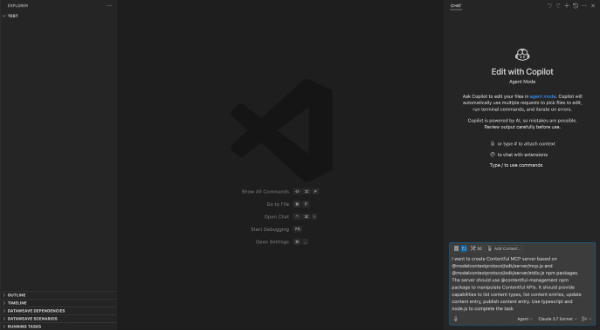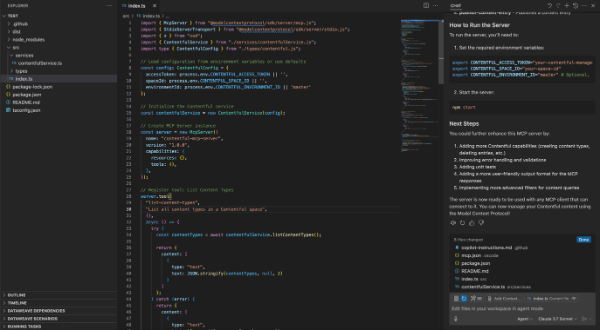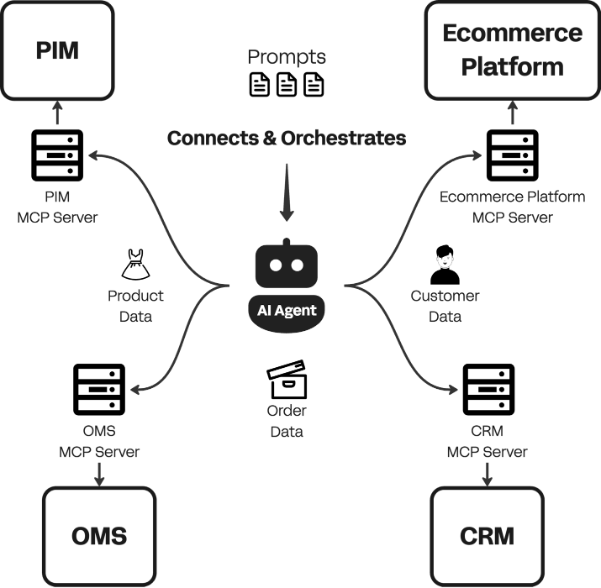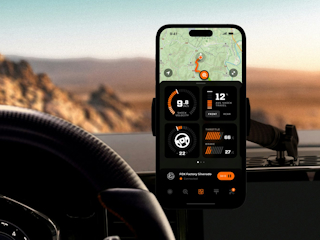The Model Context Protocol (MCP) is an open-standard, open-source framework from Anthropic (the company behind the Claude AI assistant). It standardizes the way AI and large language models (LLMs) integrate with external tools and systems.
As with any new model or initiative, there’s a huge amount of hype surrounding MCP across the AI community. But we’re not interested in a technology’s potential here at Valtech. We care about real-world solutions.
That’s why in this article I revisit a recent client project and examine how MCP could offer a transformative solution. Spoiler: The results were remarkable.
What is MCP and how does it work?
Before we dive into practical applications, let’s take a moment to understand how the technology works.
You can think of MCP as a bridge that lets an AI agent operate a tool in the same way a human would.
Rather than redesigning the tool from scratch to accommodate AI — an approach that is often impractical, especially for complex applications like web browsers or design platforms — MCP empowers AI agents to interact with existing systems naturally and efficiently.
Imagine giving a calculator to an AI agent without any additional information. The agent might recognize it visually, having trained on billions of images, but it wouldn’t be able to use it.
While school children are quick to grasp how a calculator works, an AI agent only “understands” calculators through textual descriptions and images. It lacks the operational context to perform sums.
By deploying an MCP server between the AI agent and the tool, however, businesses can provide precise instructions that let the AI act like a human without redesigning the tool itself.
A real-world problem for an online retailer
Our client, a global ecommerce retailer with localized experiences in 10 languages, came to us with a problem. They had 10,000 product images, but none of them had descriptions. That’s not ideal from an inclusiveness, accessibility or SEO perspective.
To solve this, the client wanted to write localized descriptions for every image. That’s 100,000 unique product descriptions — an immense task.
A couple of years ago, the only way to complete this work would have been to hire a dedicated team of writers and translators for six months. That would have been an expensive and slow fix for a problem that’s now much easier to solve.
AI offers a fast and effective solution
Thanks to AI, we were able to build a faster and more cost-effective solution for the online retailer. Instead of assembling a large team, two engineers were able to automate the task using a relatively simple architecture and Contentful’s REST APIs.
Our solution detected missing descriptions, generated them in English, translated them into the nine other languages and pushed everything back to the CMS. We delivered all the localized image descriptions within four weeks, rather than six months — a significant improvement on expected timelines and a very happy client.
But our solution, although effective, was just a one-off. It wasn’t flexible and it couldn’t be reused. I knew we could do better. We just didn’t have the technology yet.
MCP and AI agents: A better way to solve, reuse and scale
I revisited the problem a few weeks ago, armed with MCP and an AI agent in the form of GitHub Copilot.
I started using GitHub Copilot in agentic mode to build an MCP server for Contentful. It took 30 minutes.

Picture 1: Asking GitHub Copilot Agent to generate MCP server for Contentful
Then I spun up a second MCP server to handle image descriptions using Google Gemini — another 15 minutes.

Picture 2: Fully functional MCP server for Contentful generated by GitHub Copilot
Finally, I wrote a detailed prompt to instruct the AI agent:
Retrieve me all entries of type Image from CMS where Description field is empty. For each retrieved entry, take value from the field called ImageURL and describe the image that can be found by that URL. Then, translate the generated description into all locales that are currently supported by CMS. Finally, update entry on CMS with description and translations for it.
It took me about an hour to create the entire solution. And it worked.
Even in a worst-case scenario — coding without Copilot assistance, project management, testing and deployment overhead — the whole project would take between one and two weeks.
That’s twice as quick as our AI-powered solution and a fraction of the time it would take an army of writers and translators.
But the real benefit of MCP isn’t speed. It’s the flexibility of the solution. With MCP, I didn’t build a tool so much as teach the AI agent how to use Contentful like a human. Next time, I won’t need to rewrite the code. I’ll just write a new prompt.
With MCP, we can shift from code-based, single-use solutions to agile prompt-based operations. It’s a game changer with enormous business potential.
What if we applied MCP to our entire architecture?
Think of the average business architecture of an online retailer.
Today, each system — CRM, OMS, PIM, ecommerce platform — is connected using hard-coded integrations. Changing one means updating many, which takes time, money and people.
Exporting orders from an ecommerce platform to an OMS, for example, typically takes one or two weeks.

Picture 3: Typical hard-coded business process setup based on direct integrations between systems
But with MCP servers acting as adapters and AI agents as orchestrators, we remove the rigidity. A well-written prompt can replace weeks of development and take just a couple of hours.

Picture 4: AI Agent as an orchestrator of business processes
Need to sync customer data across your CRM and ecommerce platform? Just write a prompt. Need to change your CRM? Just teach the agent how to use the new one.
The shift is profound:
-
Business logic moves from embedded code to flexible instructions.
-
Maintenance becomes faster, cheaper and more accessible — no longer limited to specialized dev teams.
-
Enterprise operations evolve to become modular, adaptive and AI-driven.
What happens if we change the system?
The combination of MCP and AI agents unlocks a new level of long-term system flexibility.
Imagine a business with dozens of operational flows driven by intelligent prompts. One day, they decide to switch to a new CRM.
Traditionally, this would trigger months of redevelopment, rewritten integrations and costly downtime. But with an MCP-based architecture, the transition is far simpler:
-
Deploy an MCP server for the new CRM system.
-
Provide the AI agent with updated instructions.
-
Maintain existing flows with minimal disruption.
The AI agent, guided by the MCP server, autonomously adapts to the new system, maintaining business continuity, reducing costs and keeping innovation moving.
In this model, system upgrades and migrations no longer require heavy IT lift. They become lightweight and prompt-driven, redefining what agility looks like in modern enterprises.
Looking ahead
This journey with MCP and AI agents shows that they’re not just another blue-sky innovation. They’re a fundamentally different (and effective) way of solving business problems.
The future is already here.
Providers like Figma and GitHub are already building official MCP servers. Google is working on A2A (agent-to-agent) protocols. Alongside traditional REST APIs, agentic APIs will emerge as the new standard.
We’re entering a new era of AI-led automation where complex integration code gives way to smart prompts, and rigid business processes make room for more intelligent, agile, adaptive and human-centric models.
Want to rewrite the way your business operates? Explore our work with AI or arrange a chat with one of our experts using the contact form below.











